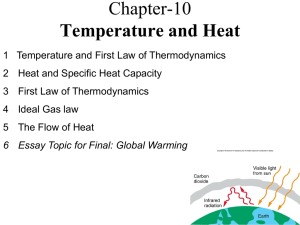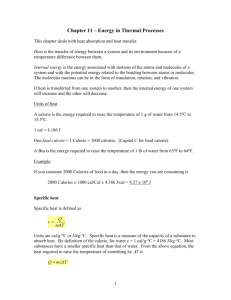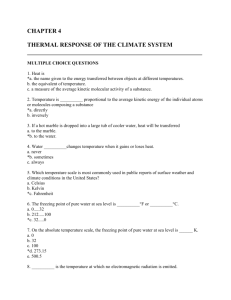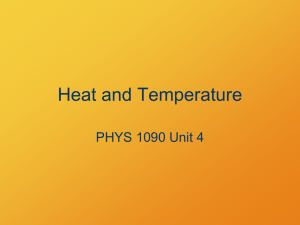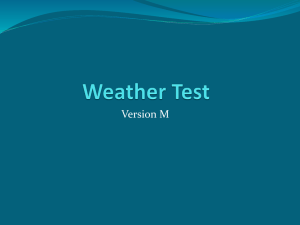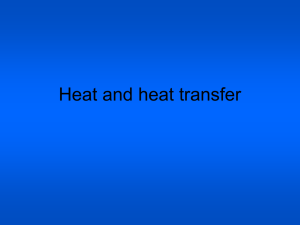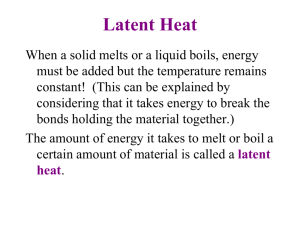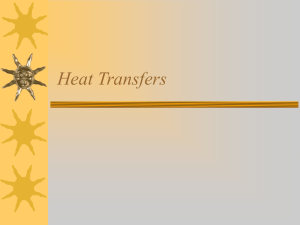Chapter4HeatTempCirc
advertisement
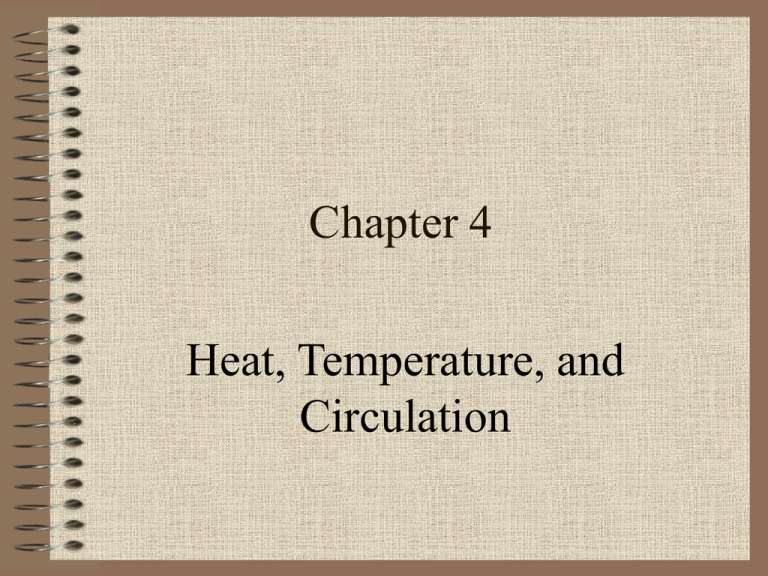
Chapter 4 Heat, Temperature, and Circulation Driving Question • What is the consequence of heat transfer in the Earth-Atmosphere System? Temperature Versus Heat • Kinetic Energy – energy within a body that is a result of motion • Heat – the total energy (kinetic and potential) of atoms or molecules composing a substance • Temperature – a measure of the average kinetic energy of the individual atoms or molecules composing a system – Temperature is NOT a type of energy, but a number used to measure kinetic energy Temperature Scales • Absolute Zero – temperature in which an objects emits no radiation –0K – -273.15 oC – -459.67 oF • Some atomic level activity still occurs Temperature Scales o • F oC o 32 = 9/5 + o o o • C = 5/9 ( F - 32 ) o • K = 5/9 ( F + 459.67) o • K = C + 273.15 Heat Units • Calorie (cal) – amount of heat needed to raise the temperature of 1 gram of water by 1 Celsius degree – This calorie has nothing to do with food calories • British Thermal Unit (Btu) – amount of heat needed to raise the temperature of 1 pound of water by 1 Fahrenheit degree • Joule (J) – most common form of measuring heat • 1 cal = 4.1868J • 1 Btu = 252cal = 1055J Measuring Air Temperature • Thermometer – device used to measure variations in temperature • Liquid in Glass – Invented in 1593 by Galileo – Filled with mercury (freezes at –38oF) or alcohol (freezes at -179oF) • Bimetallic – Two metals bonded together (brass and iron) that bend when heated or cooled – Rigged to a pen and drum that records continuous temperature - thermograph Measuring Air Temperature • Electrical Conductor – variations in electrical resistance calibrated in terms of temperature – Used in radiosondes – Replacing liquid in glass thermometers in NWS • Cricket chirps: temperature must be above 54oF – # of chirps in 8 seconds + 4 = oC • Methods for accurate measurements – Ventilation – Shielded from precipitation, direct sunlight, night sky – Located away from obstacles such as trees, buildings Heat Transfer • Temperature Gradient – a change in temperature with distance • Second Law of Thermodynamics (Entropy) – all systems tend towards disorder trying to eliminate gradients – Heat flows from higher temperature to lower temperature to erase the gradient – Larger the gradient the faster the rate of change • Types – Conduction, Convection, Radiation Radiation • Form of energy and energy transfer • Can travel through a vacuum • Principal means of EA system gaining heat from the sun and heat escaping to space • Radiational Heating – absorption > emission • Radiational Cooling – absorption < emission • Radiational Equilibrium - absorption = emission • In equilibrium temperature is constant, though different parts may be different temperatures Convection • Convection – transport of heat within a fluid due to the motions of the fluid itself – Only occurs in liquids and gases • In the atmosphere, it is caused by differences in air density – Cold dry air sinks because it is more dense – Warm moist air rises • This air expands, cools, and sinks again Conduction • Conduction – transfer of kinetic energy (heat) through collisions of molecules • Heat Conductivity – ratio of the rate of heat transport to a temperature gradient – Solids are best conductors, gases are worst – Poor conductors are good insulators (still air) Thermal Response • Specific Heat – the amount of heat needed to raise 1 gram of a substance 1 degree Celsius (a calorie) • Q = mc(ΔT) – – – – Q: change in heat (calories, Joules) m: mass of object (grams) c: specific heat capacity (calories/gram oC) ΔT: change in temperature (oC) • A higher value of “c” indicates a greater ability to store heat and resist temperature change • Thermal Inertia – resistance to temperature change Thermal Response • Because water retains heat better than land, areas near the coast have less temperature variation throughout the year Global Radiation Balance Heat Imbalance (Surface v. Atmosphere) • Earth’s surface undergoes net radiational heating • Earth’s atmosphere undergoes net radiational cooling • In response to this unbalance heat is transferred to the atmosphere from the surface Sensible Heating • Transport of heat from one place to another by way of conduction, convection, or both • Examples – Warm winds blowing over snow covered ground – Warm winds blowing over relatively cool ocean surface Latent Heat • Latent Heat – the heat that is involved in the phase changes of water – Example: cloud formation • Latent Heat of Melting (s l) – 80 cal/g added • Latent Heat of Fusion (freezing: l s) – 80 cal/g released Latent Heat • Latent Heat of Vaporization (evaporation: l g) – 540 cal/g at 100oC added – 600 cal/g at 0oC added – 680 cal/g at 0oC added (sublimation: s g) • Latent Heat of Fusion – Same numbers – except heat is released – condensation: g l – deposition: g s 680 cal/g 80 cal/g 540-600 cal/g Cooling of Earth’s Surface Bowen Ratio • BR = sensible heating/latent heating • For the earth BR = 7/23 = 0.3 Heat Imbalance (Tropics v. Poles) Heat Imbalance (Tropics v. Poles) • Tropical Areas: incoming solar radiation is greater than outgoing IR radiation • Polar Areas: incoming solar radiation is less than outgoing IR radiation • Global Radiative Equilibrium: surplus of solar radiation = deficit of IR radiation • Excess heat in tropics is transported to higher latitudes by air masses Response to Heat Imbalance: Weather • Heat imbalances create temperature gradients – Between surface and troposphere – Between tropics and polar latitudes • Heat is transported by conduction, convection, clouds, air masses, storms – Circulation of the atmosphere • Circulation brings about changes in the state of the atmosphere – WEATHER Temperature Variations • • • • Time and Day of year: solar intensity, angle Cloud Cover Surface Characteristics (albedo) Temperature is warmer when – – – – – It is daylight Under clear skies during the day Under cloudy skies during the night When the ground is not snow covered When the ground is dry Air Mass Advection • Movement of an air mass from one place to another • Warm Air Advection (WAA) – Movement of warm air • Cold Air Advection (CAA) – Movement of cold air • Advection occurs when isobars and isotherms are NOT parallel Degree Days • Based on 65oF • Approximations of residential fuel demands for heating and cooling • Heating Degree Day – HDD = 65oF – Average Daily Temperature • Cooling Degree Day – CDD = Average Daily Temperature - 65oF Wind 0.16 Chill • WC = 35.74 + 0.6215T – 35.75(V – T = Temperature in Fahrenheit – V = wind velocity in miles per hour ) + 0.4275T(V0.16)
